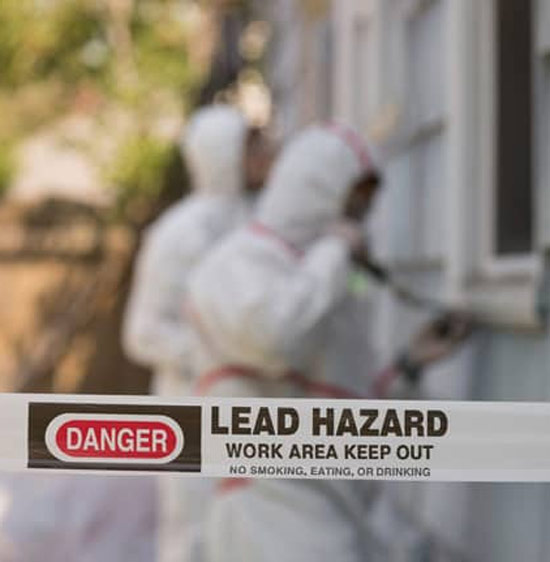Comprehensive Lead Paint Removal Service in NYC-- Certified and Certified
Comprehensive Lead Paint Removal Service in NYC-- Certified and Certified
Blog Article
Comprehensive Overview on Effective Lead Infraction Removal Methods
In the world of ecological security, attending to lead offenses requires a thorough and structured strategy. This comprehensive overview starts by highlighting the important initial actions of recognizing lead threats through sophisticated analysis and screening techniques. Strategies such as XRF analysis and dust clean tasting are vital in determining contamination sources. The guide clarifies on the relevance of sticking to rigorous safety procedures throughout the elimination process, consisting of the usage of proper PPE and isolating affected locations. The succeeding sections assure to review post-removal verification and preventative strategies, ensuring long-lasting safety and compliance. Discover the complex information that make these strategies not just reliable yet necessary.
Determining Lead Threats
Recognizing lead hazards is a vital very first action in minimizing the risks connected with lead direct exposure. Lead, a poisonous steel, can be existing in various ecological mediums, consisting of paint, dirt, water, and dust.
The first phase in recognizing lead hazards includes recognizing common lead resources within the constructed setting. Frameworks developed prior to 1978 are especially susceptible due to the prevalent usage of lead-based paint during that period. Additionally, soil contamination can happen from wearing away exterior paint, industrial emissions, or historical use of leaded fuel.
One more substantial source is lead piping and pipes components, which can seep lead into drinking water. Durable goods such as toys, ceramics, and imported products may likewise contain unsafe lead degrees. Significantly, work environments and hobbies including lead can track contaminants into homes.
Assessment and Testing
When addressing lead hazards, reliable evaluation and testing are extremely important. First evaluation generally includes a visual evaluation to recognize potential lead resources, such as wearing away paint or infected dust.

Dirt clean tasting is another essential technique, especially in household setups. By collecting samples from floors, windowsills, and various other surface areas, this approach offers understandings into possible direct exposure risks. Furthermore, dirt testing around building borders is crucial to find lead contamination that might present dangers, particularly to children.
Safe Removal Procedures
Upon finishing extensive evaluation and testing, applying safe removal treatments is the following important phase in attending to lead hazards. This process ensures that lead-contaminated products are properly and securely eliminated, reducing danger to both workers and locals. The primary step includes isolating the damaged location making use of plastic bed linen and proper securing strategies to prevent the spread of lead dust.
Workers have to don proper individual safety equipment (PPE), consisting of respirators, handwear covers, and non reusable coveralls, to mitigate direct exposure. Utilizing specialized devices and damp techniques, such as damp fining sand or using HEPA-filtered vacuum cleaners, lowers the dispersion of lead bits. It is important to prevent dry fining sand or unpleasant blasting, as these techniques can generate harmful lead dust.
Waste disposal is one more essential part; all contaminated products need Resources to be firmly bagged and labeled according to EPA and neighborhood policies. Furthermore, extensive cleaning of the workspace with HEPA vacuum cleaners and wet wiping makes certain the removal of residual lead bits.
Post-Removal Confirmation

Confirmation of successful lead removal, recognized as post-removal confirmation, is necessary to guarantee the safety and security and habitability of the remediated area. This process entails a collection of careful evaluations and tests designed to discover any recurring lead fragments that might position health risks. The initial action typically includes an aesthetic inspection to analyze the completion and high quality of the remediation work. This inspection makes sure that all known sources of lead have actually been dealt with which no noticeable signs of contamination continue to be.
Complying with the visual evaluation, environmental tasting is carried out. This includes gathering dirt, dirt, and occasionally water examples from the remediated area. Recognized laboratories analyze these examples to view website determine lead levels, guaranteeing they drop below the safety thresholds developed by regulatory bodies such as the Epa (EPA)
Additionally, air quality testing might be done to spot airborne lead bits, particularly in cases where considerable lead-based paint elimination or improvement has taken place. The results of these examinations give quantitative information verifying that the lead degrees are within permissible restrictions.
Inevitably, post-removal verification works as a vital checkpoint, verifying the performance of the lead abatement efforts and safeguarding the health of passengers and visitors.
Safety Nets and Maintenance

A crucial safety net consists of using lead-safe licensed specialists for any type of remodelling, repair service, or paint tasks. These professionals are trained in practices that minimize lead dirt and debris. Furthermore, maintaining colored surfaces to avoid breaking or peeling is crucial, as degrading paint can release lead fragments right into the setting.
Educational campaigns web link targeting homeowner and lessees pertaining to the threats of lead and the significance of reporting any type of possible dangers can further enhance preventive efforts. Routine cleaning making use of HEPA vacuum cleaners and wet wiping strategies can considerably reduce lead dust buildup.
Conclusion
In summary, effective lead violation elimination demands a meticulous method encompassing complete assessment, precise screening, and strict removal treatments. Ensuring security through appropriate seclusion and individual safety tools stays paramount. Post-removal verification via environmental tasting and air high quality testing validates compliance with well established security standards. Ongoing examinations and upkeep are important to alleviate future lead hazards, thereby guarding public health and wellness and ensuring sustained conformity with regulative requirements.
Report this page